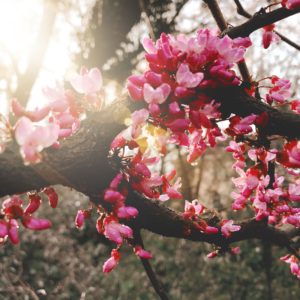Guest blogger: Roxy Drew, Caretaking Manager extraordinaire
As we move with the rhythms of nature and the cyclical motion of the changing seasons, we find ourselves shaking off our winter blues and stretching out to once again reengage with our earth. After dreaming and planning for this year’s garden all winter, we desire to sink our toes into the warming soil and once again breathe that fresh spring air. We begin to hear the hums of the bees and chirping of the birds busy about, and we, too, are pulled to join them in our gardens. There is much to do to get our beds ready for action!

Part 1: Observe and Design
As permaculturists, observation is one of our most valuable tools to ensure a healthy and productive garden. What worked well this past year? What did the land teach you about how it wanted to grow? Were there any pests that liked particular areas, plants, or crops? This is the time to make any changes to the design by transplanting, propagating, planting, and/or deleting. Then ensure you have the right natural supplies to prevent pests and disease from having a devastating effect on your garden. Consistency is vital when applying natural pest deterrents and remedies- so create a plan and stick to it! Try diversifying your plantings, intercropping, crop rotation, and incorporating aromatic plants as natural pest deterrents are great strategies to incorporate into a lower maintenance garden. Basil, mint, marigolds, hyssop, rosemary, chives, and nasturtiums are some of our favorites!
Part 2: Repair Earthworks or Garden Structures
Spring is also a great time to repair earthworks or garden structures that did not weather the winter. Check your rain gardens, berms, and swales to ensure everything is in working order, and there are no signs of water runoff or erosion. Speaking of water, be sure to turn on your drip irrigation and set it to a schedule that is just right for your garden’s needs. Having a timer is an easy way to manage irrigation. If you do not use drip irrigation, be mindful of when you water and how much water is sitting on the leaves of your plants, as this could lead to fungus and disease. Watering in the early morning is the best time to mitigate the risks associated with this!
Part 3: Pruning
In our Zone 8 climate, March and April are the final months to do any pruning on our trees. You’ll also want to keep your eye out for any sudden weather changes- if your fruit trees have started budding and bearing fruit, a drop in temperature could be detrimental to your harvest. Keep some old sheets and blankets handy if you have a sudden freeze warning.
Have Annual Beds?
You will want to harvest any winter crop and or chop and drop. This can be great green manure for your garden! One of our favorite cover crops is fava beans. Not only is the plant beautiful during the winter, has sweet flowers for our pollinators, but it also produces a bountiful harvest around this time of year. Once we harvest our beans, we chop and drop the stalks and leave the roots in the ground to decompose in place. This will naturally add nutrients back to these hard-working beds. Then top off with a fresh layer of compost and mulch to add back nutrients and ensure the bed will retain those nutrients and moisture through the summer months. You can plant your cool-season crops straight into your beds at this time and begin warm-season seeds in a greenhouse, cold frame, or just on some racks inside. Be sure to harden those seeds off outside as the temperature warms up!
With so much to do during this season, we hope that you also find time to sit and soak in the beauty of new beginnings that is before you!